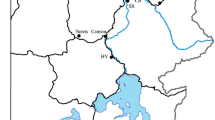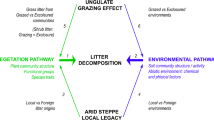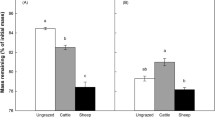Abstract
Livestock grazing affects plant community composition, diversity, and carbon (C) and nutrient cycling in grasslands. Grazing leads to plant communities that have higher relative abundance of grazing-tolerant species, which in turn may alter the chemical composition of biomass and subsequent litter decomposition rates. To better understand the effects of long-term grazing and associated vegetation shifts on biogeochemical cycling in northern temperate grasslands of western Canada, we studied litter decomposition over 18 months at 15 locations, stratified across the Mixed-grass Prairie, Central Parkland, and Foothills Fescue natural subregions. At each location, we examined decomposition in an area exposed to grazing and an area where cattle were excluded. We used litterbags containing leaf litter from seven major grass species representing different grazing tolerances and included a local source of community litter from each study site and cellulose paper as standards. Decomposition was affected by litter types, with litter from grazing-tolerant species such as Poa pratensis and Bouteloua gracilis having faster decomposition rates compared to grazing-intolerant species, supporting the hypothesis that changes in vegetation composition due to grazing influences biogeochemical cycling by modifying litter decomposition in grasslands. Litter decomposition was also overall most rapid in the cool–wet Foothills Fescue, followed by the temperate mesic Central Parkland, and slowest in the warmer–drier Mixed-grass Prairie. Combined with known grazing-induced changes in grassland composition, these findings indicate that livestock grazing may accelerate litter decomposition rates in the more mesic Foothills Fescue and parkland regions, but not the more arid Mixed-grass Prairie. Overall, this study elucidates the role of livestock grazing and its associated effects on litter decomposition and ecosystem processes in northern grassland ecosystems.




Similar content being viewed by others
References
Adair EC, Parton WJ, del Grosso SJ, Silver WL, Harmon ME, Hall SA, Burke IC, Hart SC. 2008. Simple three-pool model accurately describes patterns of long-term litter decomposition in diverse climates. Glob Change Biol 14:2636–60.
Aerts R. 1997. Climate, leaf litter chemistry and leaf litter decomposition in terrestrial ecosystems: a triangular relationship. Oikos 79:439–49.
Aerts R, De Caluwe H. 1997. Nutritional and plant-mediated controls on leaf litter decomposition of Carex species. Ecology 78:244–60.
Anderson JM. 1991. The effects of climate change on decomposition processes in grassland and coniferous forests. Ecol Appl 1:326–47.
Biondini ME, Patton BD, Nyren PE. 1998. Grazing intensity and ecosystem processes in a northern mixed-grass prairie, USA. Ecol Appl 8:469–79.
Bork EW, Blonski L. 2012. Short-term native grassland compositional responses following liquid hog manure application. Can J Plant Sci 92:55–65.
Bremer DJ, Auen LM, Ham JM, Owensby CE. 2001. Evapotranspiration in a prairie ecosystem: effects of grazing by cattle. Agron J 93:338–48.
Burke C, Steinberg P, Rusch D, Kjelleberg S, Thomas T. 2011. Bacterial community assembly based on functional genes rather than species. Proc Natl Acad Sci 108:14288–93.
Cornelissen JHC. 1996. An experimental comparison of leaf decomposition rates in a wide range of temperate plant species and types. J Ecol 84:573–82.
Cornelissen JHC, Thompson K. 1997. Functional leaf attributes predict litter decomposition rate in herbaceous plants. New Phytol 135:109–14.
Coughenour MB. 1991. Spatial components of plant-herbivore interactions in pastoral, ranching and native ungulate ecosystems. J Rangel Manag 44:530–42.
Coulson JC, Butterfield J. 1978. An investigation of the biotic factors determining the rates of plant decomposition on Blanket Bog. J Ecol 66:631–50.
DeAngelis KM, Silver WL, Thompson AW, Firestone MK. 2010. Microbial communities acclimate to recurring changes in soil redox potential status. Environ Microbiol 12:3137–49.
De Deyn GB, Quirk H, Yi Z, Oakley S, Ostel NJ, Bardgett RD. 2009. Vegetation composition promotes carbon and nitrogen storage in model grassland communities of contrasting soil fertility. J Ecol 97:864–75.
Derner JD, Boutton TW, Briske DD. 2006. Grazing and ecosystem carbon storage in the North American great plains. Plant Soil 280:77–90.
Deutsch ES, Bork EW, Willms WD. 2010. Soil moisture and plant growth responses to litter and defoliation impacts in Parkland grasslands. Agric Ecosyst Environ 135:1–9.
Dormaar JF, Adams BW, Willms WD. 1994. Effect of grazing and abandoned cultivation on a Stipa-Bouteloua community. J Range Manag 47:28–32.
Dyer MI, Acra MA, Wang GM, Coleman DC, Freckman DW, McNaughton SJ, Strain BR. 1991. Source-sink carbon relations in two Panicum coloratum ecotypes in response to herbivory. Ecology 72:1472–83.
Fioretto A, Nardo CD, Papa S, Fuggi A. 2005. Lignin and cellulose degradation and nitrogen dynamics during decomposition of three leaf litter species in a Mediterranean ecosystem. Soil Biol Biochem 37:1083–91.
Follett R, Kimble J, Lal R. 2000. The potential of U.S. grazing lands to sequester soil carbon. The potential of U.S. grazing lands to sequester carbon and mitigate the greenhouse effect. Boca Raton: CRC Press.
Garibaldi LA, Semmartin M, Chaneton EJ. 2007. Grazing-induced changes in plant composition affect litter quality and nutrient cycling in flooding Pampa grasslands. Oecologia 151:650–62.
Gill RA, Burke IC, Lauenroth WK, Milchunas DG. 2002. Longevity and turnover of roots in the shortgrass steppe: influence of diameter and depth. Plant Ecol 159:241–51.
Harmon ME, Nadelhoffer KJ, Blair JM. 1999. Measuring decomposition, nutrient turnover, and stores in plant litter. In: Robertson GP, Coleman DC, Bledsoe CS, Sollins P, Eds. Standard soil methods for long-term ecological research. New York: Oxford University Press. p 202–40.
Harmon ME, Krankina ON, Yatskov M, Matthews E. 2000. Predicting broad-scale carbon stores of woody detritus from plot-level data. In: Lal R, Kimble JM, Follett RF, Stewart BA, Eds. Assessments methods for soil carbon. Boca Raton: Lewis Publishers. p 533–52.
Harmon ME, Silver WL, Fasth B, Chen H, Burke IC, Parton WJ, Hart SC, Currie WS, LIDET. 2009. Long-term patterns of mass loss during the decomposition of leaf and fine root litter: an intersite comparison. Glob Change Biol 15:1320–38.
Hättenschwiler S, Vitousek PM. 2000. The role of polyphenols in terrestrial ecosystem nutrient cycling. Trends Ecol Evol 15:238–43.
Henderson D, Ellert B, Naeth M. 2004. Grazing and soil carbon along a gradient of Alberta rangeland. J Range Manag 57:402–10.
Hewins DB, Fatemi F, Adams B, Carlyle CN, Chang SX, Bork EW. 2015. Grazing, regional climate and soil biophysical impacts on microbial enzyme activity in grassland soil of western Canada. Pedobiologia 58:201–9.
Hewins DB, Archer SR, Okin GS, McCulley RL, Throop HL. 2013. Soil-litter mixing accelerates decomposition in a Chihuahuan desert grassland. Ecosystems 16:183–95.
Hobbie SE. 1996. Temperature and plant species control over litter decomposition in Alaskan tundra. Ecol Monogr 66:503–22.
Hobbie SE, Oleksyn J, Eissenstat DM, Reich PB. 2010. Fine root decomposition rates do not mirror those of leaf litter among temperate tree species. Oecologia 162:505–13.
Iiyama K, Wallis AFA. 1990. Determination of lignin in herbaceous plants by an improved acetyl bromide procedure. J Sci Food Agric 51:145–61.
Johansson MB, Berg B, Meentemeyer V. 1995. Litter mass-loss rates in late stages of decomposition in a climatic transect of pine forests. Long-term decomposition in a Scots pine forest. IX. Can J Bot 73:1509–21.
Jones DL, Kielland K, Sinclair FL, Dahlgren RA, Newsham KK, Farrar JF, Murphy DV. 2009. Soil organic nitrogen mineralization across a global latitudinal gradient. Glob Biogeochem Cycles 23:GB1016. https://doi.org/10.1029/2008GB003250.
Karlen DL, Mausbach MJ, Doran JW, Cline RG, Harris RF, Schuman GE. 1997. Soil quality: a concept, definition, and framework for evaluation. Soil Sci Soc Am J 61:4–10.
Klumpp K, Tallec T, Guix N, Soussana JF. 2011. Long-term impacts of agricultural practices and climatic variability on carbon storage in a permanent pasture. Glob Change Biol 17:3534–45.
Klumpp K, Fontaine S, Attard E, Le Roux X, Gleixner G, Soussana JF. 2009. Grazing triggers soil carbon loss by altering plant roots and their control on soil microbial community. J Ecol 97:876–85.
Lal R. 2002. Soil carbon dynamics in cropland and rangeland. Environ Pollut 116:353–62.
Lamb EG. 2008. Direct and indirect control of grassland community structure by litter, resources and biomass. Ecology 89:216–25.
Lensing JR, Wise DH. 2007. Impact of changes in rainfall amounts predicted by climate-change models on decomposition in a deciduous forest. Appl Soil Ecol 35:523–34.
Louault F, Pillar VD, Aufrère J, Garnier E, Soussana JF. 2005. Plant traits and functional types in response to reduced disturbance in a semi-natural grassland. J Veg Sci 16:151–60.
Menezes SC, Elliott ET, Valentine DW, Williams SA. 2001. Carbon and nitrogen dynamics in elk winter ranges. J Range Manag 54:400–8.
Naeth MA, Bailey AW, Pluth DJ, Chanasky DS, Hardin RT. 1991. Grazing impacts on litter and soil organic matter in mixed prairie and fescue grassland ecosystems of Alberta. J Range Manag 44:7–12.
Natural Regions Committee. 2006. Natural Regions and Subregions of Alberta. Compiled by Downing DJ, Pettapiece WW. Government of Alberta. Pub. No. T/852.
Olson JS. 1963. Energy storage and the balance of producers and decomposers in ecological systems. Ecology 44:322–31.
Parton W, Silver WL, Burke IC, Grassens L, Harmon ME, Currie WS, King JY, Adair EC, Brandt LA, Hart SC, Fasth B. 2007. Global-scale similarities in nitrogen release patterns during long-term decomposition. Science 315:361–4.
Pittermann J, Sage RF. 2000. Photosynthetic performance at low temperature of Bouteloua gracilis Lag., a high-altitude C4 grass from the Rocky Mountains, USA. Plant Cell Environ 23:811–23.
Placella SA, Firestone MK. 2013. Transcriptional response of nitrifying communities to wetting of dry soil. Appl Environ Microbiol 79:3294–302.
Ross LC, Woodin SJ, Hester AJ, Thompson DBA, Birks HJB. 2012. Biotic homogenization of upland vegetation: patterns and drivers at multiple spatial scales over five decades. J Veg Sci 23:755–70.
Seagle SW, McNaughton SJ. 1992. Spatial variation in forage nutrient concentrations and the distribution of Serengeti grazing ungulates. Landsc Ecol 7:229–41.
Shariff AR, Biondini ME, Grygiel CE. 1994. Grazing intensity effects on litter decomposition and soil nitrogen mineralization. J Range Manag 47:444–9.
Silver WL, Miya RK. 2001. Global patterns in root decomposition: comparisons of climate and litter quality effects. Oecologia 129:407–19.
Smoliak S, Dormaar JF, Johnston A. 1972. Long-term grazing effects on Stipa-Bouteloua prairie soils. J Range Manag 25:246–50.
Sørensen LH, Mikola J, Kytöviita M, Olofsson J. 2009. Trampling and spatial heterogeneity explain decomposer abundances in a sub-Arctic grassland subjected to simulated reindeer grazing. Ecosystems 12:830–42.
Sullivan JT, Garber RJ. 1941. The nitrogen content of Poa pratensis: its range and relation to flowering data. J Am Soc Agron 33:933–7.
Tanentzap AJ, Coomes DA. 2011. Carbon storage in terrestrial ecosystems: do browsing and grazing herbivores matter. Biol Rev Camb Philos Soc 87:72–94.
Taylor BR, Parkinson D, Parsons WFJ. 1989. Nitrogen and lignin content as predictors of litter decay rates. A microcosm test. Ecology 70:97–104.
Wardle DA, Bardgett RD, Klironomos JN, Setala H, Van der Putten W, Wall DH. 2004. Ecological linkage between aboveground and belowground biota. Science 304:1629–33.
Willms WD, Dormaar JF, Adams BW. 1996. Seasonal changes of herbage biomass on the fescue prairie. J Range Manag 49:100–4.
Willms WD, Smoliak S, Dormaar JF. 1985. Effect of stocking rate on a rough fescue grassland vegetation. J Range Manag 38:220–5.
Yates CJ, Norton DA, Hobbs RJ. 2000. Grazing effects on plant cover, soil and microclimate in fragmented woodlands in south-western Australia: implications for restoration. Austral Ecol 25:36–47.
Acknowledgements
We thank H. Feng, D. Nguyen, L. Rodvang, E, Stolnikova, M. Oloroso, G. Carscallen, K. Linquist, C. Kisko, J. King, and S. Morstad for providing field and laboratory assistance throughout the study, and M. Lyseng for litter harvesting. We are grateful to Alberta Environment and Parks for providing access to the Rangeland Reference Area study locations, and appreciate all the land owners and lease holders who generously provide access to their properties. We appreciate constructive feedback from two anonymous reviewers. This study was funded by a joint grant from the Alberta Livestock and Meat Agency and Alberta Innovates BioSolutions (Grant# 2014E007R to DBH, SXC, CNC and EWB).
Author information
Authors and Affiliations
Corresponding author
Additional information
Authors’ Contributions
DBH, EWB, CNC, and SXC designed the experiment. XC and DBH conducted the field study, and XC processed samples in the laboratory. All authors contributed to data analysis and writing of the manuscript.
Rights and permissions
About this article
Cite this article
Chuan, X., Carlyle, C.N., Bork, E.W. et al. Long-Term Grazing Accelerated Litter Decomposition in Northern Temperate Grasslands. Ecosystems 21, 1321–1334 (2018). https://doi.org/10.1007/s10021-018-0221-9
Received:
Accepted:
Published:
Issue Date:
DOI: https://doi.org/10.1007/s10021-018-0221-9




